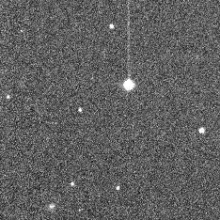
Back متلافي اصطدام كويكبي Arabic গ্রহাণুর অভিঘাত থেকে মুক্তি Bengali/Bangla Planetare Verteidigung German Estrategias de mitigación de asteroides Spanish پرهیز از برخورد سیارک Persian Stratégies de déviation des astéroïdes French הסטת אסטרואידים HE Pengelakan tumbukan asteroid ID Pengelakan hentaman asteroid Malay Evitarea impactului cu asteroizi Romanian


Asteroid impact avoidance encompasses the methods by which near-Earth objects (NEO) on a potential collision course with Earth could be diverted away, preventing destructive impact events. An impact by a sufficiently large asteroid or other NEOs would cause, depending on its impact location, massive tsunamis or multiple firestorms, and an impact winter caused by the sunlight-blocking effect of large quantities of pulverized rock dust and other debris placed into the stratosphere. A collision 66 million years ago between the Earth and an object approximately 10 kilometers (6 miles) wide is thought to have produced the Chicxulub crater and triggered the Cretaceous–Paleogene extinction event that is understood by the scientific community to have caused the extinction of all non-avian dinosaurs.
While the chances of a major collision are low in the near term, it is a near-certainty that one will happen eventually unless defensive measures are taken. Astronomical events—such as the Shoemaker-Levy 9 impacts on Jupiter and the 2013 Chelyabinsk meteor, along with the growing number of near-Earth objects discovered and catalogued on the Sentry Risk Table—have drawn renewed attention to such threats.[1] The popularity of the 2021 movie Don't Look Up helped to raise awareness of the possibility of avoiding NEOs.[2]
In 2016, a NASA scientist warned that the Earth is unprepared for such an event.[3] In April 2018, the B612 Foundation reported "It's 100 percent certain we'll be hit by a devastating asteroid, but we're not 100 percent sure when."[4] Also in 2018, physicist Stephen Hawking, in his final book, Brief Answers to the Big Questions, considered an asteroid collision to be the biggest threat to the planet.[5][6] Several ways of avoiding an asteroid impact have been described.[7] Nonetheless, in March 2019, scientists reported that asteroids may be much more difficult to destroy than thought earlier.[8][9] An asteroid may reassemble itself due to gravity after being disrupted.[10] In May 2021, NASA astronomers reported that 5 to 10 years of preparation may be needed to avoid a virtual impactor based on a simulated exercise conducted by the 2021 Planetary Defense Conference.[11][12][13]
In 2022, NASA spacecraft DART impacted Dimorphos, reducing the minor-planet moon's orbital period by 32 minutes. This mission constitutes the first successful attempt at asteroid deflection.[14] In 2025, CNSA plans to launch another deflection mission to near-Earth object 2019 VL5, a 30-meter-wide (100 ft.) asteroid, which will include both an impactor and observer spacecraft.[15][16]
- ^ Rahman, Shoaib (2021-04-10). "How Much Our Earth Is Ready To Prevent Future Asteroid Collisions?". Futurism. Archived from the original on 2021-09-12. Retrieved 2021-11-17.
- ^ Powell, Corey S. (December 20, 2021). "How prepared is Earth for an asteroid collision?". Astronomy. Archived from the original on 2021-12-20. Retrieved 2022-01-12.
- ^ Yuhas, Alan (13 December 2016). "Earth woefully unprepared for surprise comet or asteroid, Nasa scientist warns". The Guardian.
- ^ Homer, Aaron (28 April 2018). "Earth Will Be Hit By An Asteroid With 100 Percent Certainty, Says Space-Watching Group B612". Inquisitr. Archived from the original on 24 January 2020. Retrieved 28 April 2018.
- ^ Stanley-Becker, Isaac (15 October 2018). "Stephen Hawking feared race of 'superhumans' able to manipulate their own DNA". The Washington Post. Retrieved 15 October 2018.
- ^ Haldevang, Max de (14 October 2018). "Stephen Hawking left us bold predictions on AI, superhumans, and aliens". Quartz. Retrieved 15 October 2018.
- ^ Wall, Mike (2 May 2019). "A Killer Asteroid Is Coming — We Don't Know When (So Let's Be Ready), Bill Nye Says". Space.com. Retrieved 2 May 2019.
- ^ Johns Hopkins University (4 March 2019). "Asteroids are stronger, harder to destroy than previously thought". Phys.org. Retrieved 4 March 2019.
- ^ El Mir, Charles; Ramesh, KT; Richardson, Derek C. (15 March 2019). "A new hybrid framework for simulating hypervelocity asteroid impacts and gravitational reaccumulation". Icarus. 321: 1013–1025. Bibcode:2019Icar..321.1013E. doi:10.1016/j.icarus.2018.12.032. S2CID 127119234.
- ^ Andrews, Robin George (8 March 2019). "If We Blow Up an Asteroid, It Might Put Itself Back Together – Despite what Hollywood tells us, stopping an asteroid from creating an extinction-level event by blowing it up may not work". The New York Times. Retrieved 9 March 2019.
- ^ McFall-Johnsen, Morgan; Woodward, Aylin (12 May 2021). "A NASA simulation revealed that 6 months' warning isn't enough to stop an asteroid from hitting Earth. We'd need 5 to 10 years". Business Insider. Retrieved 14 May 2021.
- ^ Bartels, Meghan (1 May 2021). "How did you spend your week? NASA pretended to crash an asteroid into Earth". Space.com. Retrieved 14 May 2021.
- ^ Chodas, Paul; Khudikyan, Shakeh; Chamberlin, Alan (30 April 2021). "Planetary Defense Conference Exercise - 2021 Planetary Defense Conference (virtually) in Vienna, Austria, April 26–April 30, 2021". NASA. Retrieved 14 May 2021.
- ^ Bardan, Roxana (2022-10-11). "NASA Confirms DART Mission Impact Changed Asteroid's Motion in Space". NASA. Retrieved 2022-12-08.
- ^ Jones, Andrew (2023-04-11). "China to target asteroid 2019 VL5 for 2025 planetary defense test". SpaceNews. Retrieved 2023-04-17.
- ^ Andrew Jones published (2022-12-08). "China will launch 2-in-1 asteroid deflection mission in 2025". Space.com. Retrieved 2023-04-17.